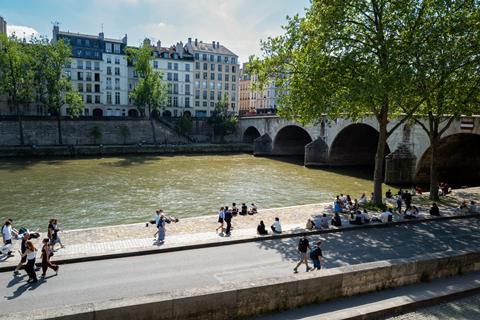The Paris Olympics has had to tackle political, environmental, and urban planning challenges, writes Sophie Thompson

There is no doubt that calling a snap election has made for a challenging backdrop to the world’s biggest sporting event. When President Macron decided that the country should go to the polls this month, Paris mayor and 15-minute city powerhouse Anne Hidalgo described the decision as extremely troubling.
Readying a city to host the 2024 Olympic and Paralympic Games, which get underway on 26 July, is a huge, off-the-charts endeavour. Even without the distraction of an election, it has not all been smooth sailing in the run-up to the greatest sporting show on Earth.
Towards the end of last year, Hidalgo said that she thought the city’s transport “wouldn’t be ready in time”. Then, instead of free transport for Games’ ticket-holders, fares across the city were to double for non-residents. In December, 44% of polled citizens thought the Games were a bad thing.
Having worked on the landscape masterplan for the 2012 London Games, this comes as no surprise. London had its fair share of “F**k the Olympics” graffiti.
It took a lot of people giving everything they had for years to create a riverine park that could quickly become a special place in its own right post-Games – a place that could shift the cultural and emotional balance of an entire city eastwards
A barrage of criticism was unleashed against what was seen by some as the folly and vandalism of “corporate redevelopment” of the derelict east London site selected to host most of the venues. Author Iain Sinclair declared that we were on “the long march towards a theme park without a theme”.
For London 2012, the landscape had to assertively match the infrastructure and the monumental Games buildings. In the end, it took a lot of people giving everything they had for years to create a riverine park that could quickly become a special place in its own right post-Games. A place that could shift the cultural and emotional balance of an entire city eastwards.
The 2012 Games were the most sustainable ever but, like any relay race, you want this to be a baton that gets handed on. The world’s understanding of the climate and biodiversity crises has changed and Paris 2024 will be bolder.
Environmental legacy is at its heart. Or, as the organisers say, “less, better, for longer”. Fewer resources, better use of these resources and then reuse. The circular economy in action.
So, Paris committed to halving the carbon footprint of their Games, covering scope 3 emissions which includes spectator travel. The Games will be powered on 100% renewable energy.
For the first time, the organisers will be calculating the material footprint of each host venue. Almost all the venues are pre-existing or temporary, with the remaining 5% low-carbon builds.

And, like London 2012, regeneration is of course a massive driver. As Ken Livingstone, the mayor when London bid for the Games, explained back in 2008: “I didn’t bid for the Olympics because I wanted three weeks of sport… I bid because it’s the only way to get billions of pounds out of the government to develop east London – to clean the soil, put in the infrastructure, build the housing.”
Paris 2024 is seen as the chance to create momentum for a new social project, with the communities in the Seine-Saint-Denis suburb, north-east of the Paris ring road, set to benefit the most. It is a poor area with high unemployment (20%), issues around drugs, and recorded as having the highest crime rate in metropolitan France.
This is where the main Olympic village will be, which after the Games will become a mixed-use place to live and work for 6,000 people, providing mostly social or affordable housing. The aquatics centre will become a community multi-use sports. Noise from the ring road has been reduced, improving the quality of life for everyone living there.
What a wonderful, romantic ambition, to make the Seine swimmable again
All this mirrors the scale and ambition of the wider city’s transformation. Hidalgo wants Paris to become “the greenest big city in Europe”, a bio-climatic city with diverse, climate-resilient urban forest planting across the city, including for key destinations, and a goal to make 50% of the city’s surfaces planted and permeable.
And we have got used to seeing Parisians cycling en masse along 1,300km of cycle lanes laid out since her election a decade ago, on avenues once too terrifying to cross. There has said to have been a 40% drop in air pollution in this time too.
Now there will be swimming in the Seine, for the first time in more than 100 years. This is one of the big environmental promises from the Games organisers, a ¢1.4bn (£1.89bn) investment in water management, with a huge basin in Austerlitz designed with a capacity of 46 million litres, so that water can be cleaned before entering the Seine.
Trials have been thwarted by unusually wet weather. That delayed a planned swim by Hidalgo which finally took place last week to demonstrate the water quality. Four Olympic and Paralympic events will take place in the river and, thanks to the Games as an accelerator, public bathing areas will be ready next year.
What a wonderful, romantic ambition, to make the Seine swimmable again. No wonder all eyes are on Paris this year. Not only for this Games, but also for answers to the most important questions of our time: how do you achieve change at pace, and how do you take people with you?
Sophie Thompson is a landscape architect and director at LDA Design
Postscript
Sophie Thompson is Head of Public Realm and a board member at LDA Design


























No comments yet